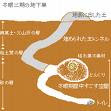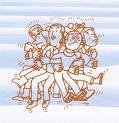[ . BACK to WORLDKIGO TOP . ]::::::::::::::::::::::::::::::::::::::::::::::::::::::::::::::::::::::::::::::::::::::::::::::::::::
Plants in Winter
***** Location: Japan
***** Season: Winter
***** Category: Plant *****************************
Explanation
Many plants have their main entry in a different season and when mentioned in winter, this has to be added explicitly
plants in winter
Please check the entries carefully!
In winter, we have the fallen leaves and many withered plants.
Many compound words take the part of "winter" or "in the cold".
LIST of the Plants in our WKD databasePLANTS - in all WINTER kigo List kusa くさ【草】this word is used for all kinds of grass, weeds, herbs, wild plants, wild flowers and such.
I use "plant" as a general translation.
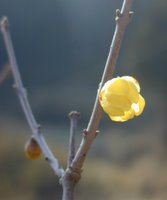
:::::::::::::::::::::::::::::::::::::::::::::::::::::::::::::::::::::::::::::::::::::::::::::::::::
Kigo for early winter fuyuaoi, fuyu aoi 冬葵 (ふゆあおい) hollycock in winter mallow in winter
kan aoi 寒葵 hollycock in the cold
Asarum nipponicum
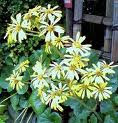 tsuwa no hana 石蕗の花 (つわのはな)
tsuwa no hana 石蕗の花 (つわのはな)
rock butterbur flowers
..... tsuwabuki no hana 石蕗の花(つわぶきのはな)
..... 槖吾の花(つわぶきのはな)
tsuwa saku 石蕗咲く(つわさく)
Farfugium japonicum
tsuwabuki, Japanese silverleaves or Hosta, is Aureomaculata, with spotted leaves and called "leopard plant", one of the edible mountain plants.
. WASHOKU
tsuwazushi, tsuwa sushi つわ寿司 from Tosa, Shimizu
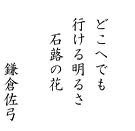
:::::::::::::::::::::::::::::::::::::::::::::::::::::::::::::::::::::::::::::::::::::::::::::::::::
Kigo for mid-winter kurisumasu roozu クリスマスローズ christmas rose Helleborus orientalis
. . . CLICK here for Photos !:::::::::::::::::::::::::::::::::::::::::::::::::::::::::::::::::::::::::::::::::::::::::::::::::::
Kigo for late winter fuyumoe, fuyu moe 冬萌 (ふゆもえ) sprouts in winter
(the first green under withered leaves)
 habotan 葉牡丹 (はぼたん) "leaf peony"
habotan 葉牡丹 (はぼたん) "leaf peony" decorative cabbage
botan na 牡丹菜(ぼたんな)
Brassica oleracea
It is planted in many large flowerbeds in the towns. Its beautiful color gradations are enjoyable throughout the long winter days.
yukiore, yuki ore 雪折 (ゆきおれ) "breaking from the snow" branches of many trees break during the heavy snow season, so do sasa grass and bamboo.
:::::::::::::::::::::::::::::::::::::::::::::::::::::::::::::::::::::::::::::::::::::::::::::::::::
Kigo for all winter kimamori 木守 (きまもり)
One last fruit (or a few) is left on the tree to "watch over it". ..... kimori 木もり(こもり
..... kimaburi 木まぶり(きまぶり)
kimori gaki 木守柿 / kimamorigaki きまもりがき last persimmon
kimori yuzu 木守柚(きもりゆず) last yuzu citron
. miyama shikimi 深山樒 (みやましきみ) Skimmia . Skimmia japonica
murozaki 室咲 (むろざき / 室咲き) "flowering in the greenhouse" muro no hana 室の花(むろのはな)
flowers from the greenhouse / hothouse
muro no ume 室の梅(むろのうめ) plums in the greenhouse
Blumen aus dem Gewächshaus
.................................................................................
***************************** Worldwide use*****************************
Things found on the way*****************************
HAIKU*****************************Related wordsWINTER . . . . . PLANTS -
SAIJIKI List . . .
. WINTER
the complete SAIJIKI . WKD ... ALL SAIJIKI ... LIST :::::::::::::::::::::::::::::::::::::::::::::::::::::::::::::::::::::::::::::::::::::::::::::::::::
WINTER PLANTS -
SAIJIKI List BACKUP of the Yahoo ListAAA . . . Plants in Winter Saijiki Introduction
http://wkdkigodatabase03.blogspot.com/2010/10/plants-in-winter-saijiki.html worldkigo
apples in winter (fuyu ringo, kan ringo)
Malus domestica
http://worldkigo2005.blogspot.com/2005/01/apple-ringo-05.html worldkigo
Edit Delete Cut
aralia flowers (yatsude no hana)
Fatsia japonica
http://wkdkigodatabase03.blogspot.com/2008/01/fatsia-blossoms-hana-yatsude.html worldkigo
Edit Delete Cut
ardisia japonika (yabukooji, yama tachibana)
Ardisia japonica
http://washokufood.blogspot.com/2008/07/kankitsurui.html worldkigo
Edit Delete Cut
aucuba berries (aoki no mi)
Aucuba japonica, kind of Japanese laurel
http://haikuandhappiness.blogspot.com/2007/12/red-berries.html worldkigo
Edit Delete Cut
banana plants withering (karebashoo)
more BANANA PLANT kigo
http://worldkigodatabase.blogspot.com/2006/07/skunk-cabbage-mizu-bashoo.html worldkigo
Edit Delete Cut
bracke fern in winter (fuyu warabi)
Pteridium aquilinum var. latiusclum
http://washokufood.blogspot.com/2008/04/mori-no-megumi.html worldkigo
Edit Delete Cut
bush clover withered (karehagi, kare hagi)
Lespedeza fam. more BUSH CLOVER kigo
http://wkdkigodatabase03.blogspot.com/2007/09/bush-clover-hagi.html worldkigo
Edit Delete Cut
camellia in winter (fuyu no tsubaki), sazanka, wabisuke
Camellia japonica
http://worldkigodatabase.blogspot.com/2005/03/camellia-tsubaki.html worldkigo
Edit Delete Cut
cattleya (katorea)
more ORCHID kigo
http://darumamuseum.blogspot.com/2007/12/orchid-daruma.html worldkigo
Edit Delete Cut
cherry blossoms in winter (fuyuzakura)
more about cherry blossoms in autumn and winter
http://worldkigodatabase.blogspot.com/2005/01/autumn-cherry-blossom-shikizakura.html worldkigo
Edit Delete Cut
chloranthus glaber (senryoo)
Sarcandra glabra. "coral plant"
http://haikuandhappiness.blogspot.com/2007/12/red-berries.html worldkigo
Edit Delete Cut
christmas cactus (shako saboten)
Schlumbergera bridgesii. Weihnachtskaktus
http://worldkigodatabase.blogspot.com/2006/04/poinsettia.html worldkigo
Edit Delete Cut
christmas rose (kurisumasu roozu)
Helleborus orientalis
http://wkdkigodatabase03.blogspot.com/2010/10/plants-in-winter-saijiki.html worldkigo
Edit Delete Cut
chrysanthemum in winter (fuyugiku)
more CHRYSANTHEMUM kigo
http://worldkigodatabase.blogspot.com/2005/03/chrysanthemum-kiku.html worldkigo
Edit Delete Cut
citrus fruit in winter
mikan, satsuma, tachibana and many others
http://washokufood.blogspot.com/2008/07/kankitsurui.html worldkigo
Edit Delete Cut
cleavers are withered (kare mugura)
more CLEAVER kigo
http://worldkigodatabase.blogspot.com/2010/04/cleavers-mugura.html worldkigo
Edit Delete Cut
coral berry (manryoo)
Ardisia crenata
http://haikuandhappiness.blogspot.com/2007/12/red-berries.html worldkigo
Edit Delete Cut
cotton rose withered (kare fuyoo)
more WITHERED kigo
http://wkdkigodatabase03.blogspot.com/2007/07/withered-fields-kareno.html worldkigo
Edit Delete Cut
dropwort in winter (fuzuzeri), dropwort in the cold (kanzeri)
Oenanthe javanica. Japanese parsely, seri
http://washokufood.blogspot.com/2009/04/spring-vegetables-start.html worldkigo
Edit Delete Cut
fern is withering (kare shida)
Gleichenia japonica, Polypodium polypodioides. more FERN kigo
http://worldkigo2005.blogspot.com/2005/06/fern-shida.html worldkigo
Edit Delete Cut
fields in winter (fuyu no)
fuyu no hara and more
http://wkdkigodatabase03.blogspot.com/2007/07/withered-fields-kareno.html worldkigo
Edit Delete Cut
flowers outside of season (kaeribana)
cherry blossom and others
http://worldkigodatabase.blogspot.com/2005/06/flower-and-hana.html worldkigo
Edit Delete Cut
fruits of winter
a KIGO list
http://washokufood.blogspot.com/2008/07/kudamono-fruits-obst.html worldkigo
Edit Delete Cut
greenhouse flowers (murozaki)
http://wkdkigodatabase03.blogspot.com/2010/10/plants-in-winter-saijiki.html worldkigo
Edit Delete Cut
holly flowers (hiiragi no hana)
Osmanthus heterophyllus
http://washokufood.blogspot.com/2009/02/ehoomaki-sushi.html worldkigo
Edit Delete Cut
hollycock mallow in winter (fuyu aoi)
http://wkdkigodatabase03.blogspot.com/2010/10/plants-in-winter-saijiki.html worldkigo
Edit Delete Cut
ivy, Japanese ivy in winter (fuyuzuta)
Parthenocissus tricuspidata
http://wkdkigodatabase03.blogspot.com/2009/10/acebia-akebi.html worldkigo
Edit Delete Cut
kashiwa oak in winter (fuyu kashiwa)
more OAK kigo
http://worldkigodatabase.blogspot.com/2010/08/oak-trees-quercus.html worldkigo
last fruit on the tree (kimori, ki mamori)
last persimmon, last yuzu . . .
http://wkdkigodatabase03.blogspot.com/2010/10/plants-in-winter-saijiki.html
lawn is withered (kareshiba, kare shiba)
more LAWN kigo
http://wkdkigodatabase03.blogspot.com/2008/05/lawn-shiba.html worldkigo
Edit Delete Cut
leaf peony (habotan)
Brassica oleracea. wild cabbage
http://wkdkigodatabase03.blogspot.com/2010/10/plants-in-winter-saijiki.html worldkigo
Edit Delete Cut
leaves are falling (momiji chiru)
red leaves in winter, fuyu momiji
http://worldkigodatabase.blogspot.com/2005/01/autumn-leaves-momiji.html worldkigo
Edit Delete Cut
leaves of trees (konoha, ko no ha)
more LEAVES kigo for winter
http://worldkigodatabase.blogspot.com/2005/06/fallen-leaves-ochiba.html worldkigo
Edit Delete Cut
lotus plants withering (karehasu, kare hasu)
more LOTUS kigo
http://happyhaiku.blogspot.com/2005/06/lotus.html worldkigo
moss in winter (fuyu no koke)
more MOSS kigo
http://happyhaiku.blogspot.com/2006/10/moss-on-stones.html worldkigo
Edit Delete Cut
mountain pepper in winter (fuyuzanshoo)
Zanthoxylum piperitum. more KIGO
http://washokufood.blogspot.com/2008/08/mountain-pepper-sanshoo.html worldkigo
Edit Delete Cut
mushrooms in the cold (kandake)
more MUSHROOM kigo. enokidake, yukiwaritake, nameko
http://worldkigo2005.blogspot.com/2006/01/mushrooms-ki-no-ko.html worldkigo
Edit Delete Cut
nandina berries (nanten no mi)
Nandina domestica
http://worldkigo2005.blogspot.com/2006/02/nandina-blossoms.html worldkigo
Edit Delete Cut
narcissus (suisen), daffodils, jonquils
Narcissus tarzetta, Narcissus tazetta, Chinese Daffodil
http://europasaijiki.blogspot.com/2005/04/daffodil-and-narcissus.html worldkigo
Edit Delete Cut
orchid in the cold (kanran, kan ran)
more ORCHID kigo
http://darumamuseum.blogspot.com/2007/12/orchid-daruma.html worldkigo
Edit Delete Cut
pampas grass withering (kare susuki, kare obana)
more SUSUKI kigo. rushes withered
http://wkdkigodatabase03.blogspot.com/2007/10/pampas-grass-susuki.html worldkigo
Edit Delete Cut
pansy in winter (fuyu sumire)
more PANSY kigo
http://europasaijiki.blogspot.com/2006/02/pansy.html worldkigo
Edit Delete Cut
peony in winter (fuyu botan, kanbotan)
Paeonia suffruticosa, Pfingstrose
http://worldkigodatabase.blogspot.com/2006/04/peony-botan.html worldkigo
Edit Delete Cut
plum blossoms are early (soobai, kanbai. . .)
ume hayashi and more PLUM blossom kigo
http://worldkigodatabase.blogspot.com/2006/04/plum-ume.html worldkigo
Edit Delete Cut
plum blossoms in the hot house (muro no ume)
more PLUM kigo
http://worldkigodatabase.blogspot.com/2006/04/plum-ume.html worldkigo
Edit Delete Cut
poincettia
Euphorbia pulcherrima. Christmas flower
http://worldkigodatabase.blogspot.com/2006/04/poinsettia.html worldkigo
Edit Delete Cut
quince in the cold (kan boke, kanboke)
Chaenomeles japonica. more QUINCE kigo
http://寒木瓜 worldkigo
Edit Delete Cut
radish (daikon)
more RADISH kigo
http://worldkigodatabase.blogspot.com/2006/06/radish-daikon.html worldkigo
Edit Delete Cut
rock butterbur flowers (tsuwa no hana)
Farfugium japonicum. hosta, Aureomaculata. tsuwabuki no hana
http://wkdkigodatabase03.blogspot.com/2010/10/plants-in-winter-saijiki.html worldkigo
Edit Delete Cut
rose, roses in winter (fuyu no bara)
more ROSE kigo
http://worldkigo2005.blogspot.com/2007/06/rose-bara.html worldkigo
seaweed in winter
a KIGO list about seaweeds
http://haikutopics.blogspot.com/2006/06/seaweed-kaisoo.html worldkigo
Edit Delete Cut
sedge in the cold (kansuge, kan suge)
Carex morrowii.
http://wkdkigodatabase03.blogspot.com/2010/05/farmers-work-in-summer.html worldkigo
Edit Delete Cut
skimmia (miyama shikimi)
Skimmia japonica
http://wkdkigodatabase03.blogspot.com/2010/10/plants-in-winter-saijiki.html worldkigo
Edit Delete Cut
snake beard plant (ryuu no tama) "dragon pearl"
Ophiopogon japonicus
http://wkdkigodatabase03.blogspot.com/2009/05/berry-berries.html worldkigo
Edit Delete Cut
snow breaks branches (yukiore, yuki ore)
http://wkdkigodatabase03.blogspot.com/2010/10/plants-in-winter-saijiki.html worldkigo
Edit Delete Cut
strawberries in winter (fuyu no ichigo)
and more about berries in winter
http://wkdkigodatabase03.blogspot.com/2009/05/berry-berries.html worldkigo
Edit Delete Cut
sugar cane flowers (satookibi no hana)
more SUGARCANE kigo. Zuckerrohr
http://databaseworldkigo.blogspot.com/2008/04/sugarcane.html worldkigo
Edit Delete Cut
tea blossoms (cha no hana)
Thea sinensis. more kigo with TEA plants
http://washokufood.blogspot.com/2008/06/cha-tea-tee.html worldkigo
Edit Delete Cut
vegetable SAIJIKI . winter vegetables
all vegetables are HERE. bamboo, lotus, pokeroot, cabbage, spikenard, carrots, cauliflower, cellory, horse radish, leafy vegetables, leek (naga negi), lily bulbs, radish (daikon), turnips . . .
http://washokufood.blogspot.com/2009_04_01_archive.html worldkigo
Edit Delete Cut
weeds in winter (fuyu no kusa)
plants in the cold (kansoo)
http://happyhaiku.blogspot.com/2006/09/wonderful-weeds.html worldkigo
Edit Delete Cut
weeping fern withering (kare shinobu)
Lepisorus thunbergianus. more KIGO
http://worldkigodatabase.blogspot.com/2006/11/wind-chimes-fuurin.html worldkigo
Edit Delete Cut
wild rice withering (makomo karu)
more MAKOMO kigo
http://wkdkigodatabase03.blogspot.com/2007/12/ship-boat-fune.html worldkigo
Edit Delete Cut
winter corals (fuyu sango)
Solanum pseudo-capsicum. . more red berries
http://wkdkigodatabase03.blogspot.com/2009/05/berry-berries.html worldkigo
Edit Delete Cut
wintersweet (roobai)
Chimonanthus praecox
http://worldkigo2005.blogspot.com/2006/11/wintersweet-roobai.html worldkigo
Edit Delete Cut
withered fields (kareno) and withered plants
a . long . KIGO list. cockscomb, thistle, gentian, rushes and reeda
http://wkdkigodatabase03.blogspot.com/2007/07/withered-fields-kareno.html worldkigo
Edit Delete Cut
withered trees (kareki). winter trees with special names
a KIGO list. withering in the frost . . .
http://worldkigodatabase.blogspot.com/2006/11/winter-fuyu.html worldkigo
Edit Delete Cut
yellow mountain rose withered (kare yamabuki)
Kerria japonica. more YAMABUKI kigo
http://worldkigo2005.blogspot.com/2006/12/yellow-rose-yamabuki.html worldkigo
zzz . . . Plants in Winter - Saijiki
Introduction to this saijiki
http://wkdkigodatabase03.blogspot.com/2010/10/plants-in-winter-saijiki.html
:::::::::::::::::::::::::::::::::::::::::::::::::::::::::::::::::::::::::::::::::::::::::::::::::::
PLANTS - - - the Complete SAIJIKI . PLANTS IN SPRING
SAIJIKI . PLANTS IN SUMMER
SAIJIKI . PLANTS IN AUTUMN
SAIJIKI . PLANTS IN WINTER
SAIJIKI . PLANTS IN the NEW YEAR
SAIJIKI . . . . . WINTER
the complete SAIJIKI . WKD ... ALL SAIJIKI ... :::::::::::::::::::::::::::::::::::::::::::::::::::::::::::::::::::::::::::::::::::::::::::::::::::

